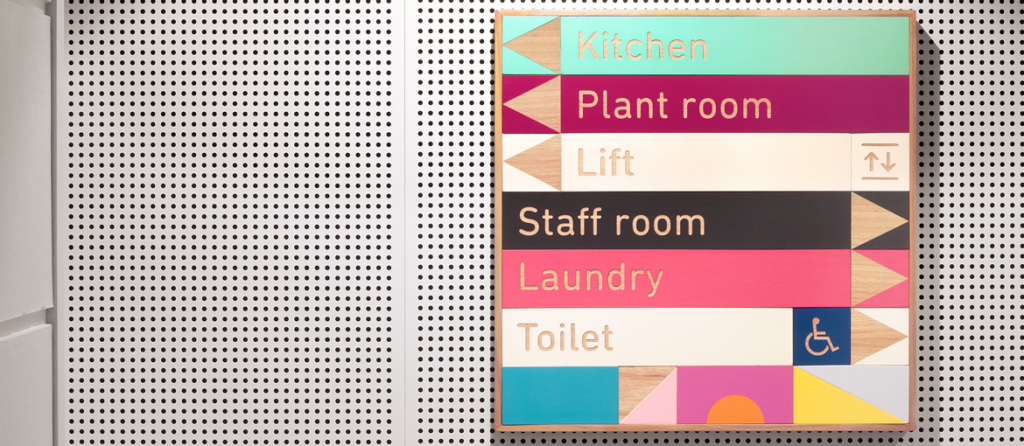Long before the invention of paper, humans left signs in their surroundings to communicate information visually. These signs were especially essential for being able to easily orient themselves in space. Over time, a common meaning related to these symbols was established; represented nowadays by the discipline of Environmental Graphic Design (EGD).
This field is relatively modern and has been formalized over the past 40 years. Previously it was associated with architecture and referred to as Architectural Graphics. Exponents of this discipline realized that there were many differences between their profession and that of a traditional graphic designer, as Environmental Graphic Design includes planning and communicating information about three-dimensional objects within a space. In 1973, the Society for Environmental Graphic Design (SEGD) was created.
Wayfinding Design is a branch of EGD. In fact, this is divided between Wayfinding Design, which orients users in a space and helps navigate it, Interpretation, which gathers information about the space, and Positioning (Placemaking), which creates the distinctive image of the space.

Signage and Wayfinding
Although they are often interchangeable, Signage is primarily concerned with signals and signs, while Wayfinding deals with the more comprehensive view of orientation within a place.
Specifically, this discipline consists of signs and symbols that visually and informatively wrap around a space, or set of spaces: airports, hotels, parks, corporate buildings, all the way to hospitals, transportation system, and entire cities.
Usefulness and limitations
In a practical sense, the role of Wayfinding Design is to create a map of the space within the mind of a user trying to navigate it. The clearer the physical structure of the space, the clearer the mental map will be.
So there is a need to keep in mind that even the best sign structure cannot solve all the problems of navigating a very complex space. Wayfinding design can facilitate navigation within a site, but relying on its physical structure has limitations.
The identity of a space
The importance of branding, and branding strategy is increasingly important within organizations, large or small, commercial or institutional. Branding strategy recognizes that a user comes into contact with a brand through a number of touchpoints, the quantity and quality of which must be taken care of.
A good strategy includes Wayfinding Design within the touchpoints to be developed and enhanced. Signage should visually connect seamlessly with the other elements of an organization’s identity.
Signage can take two different types of approaches. With the strategy of harmony, the signage structure reflects and reinforces the spatial and architectural characteristics of a space. With the approach of imposition, Wayfinding Design is designed to create a unified identity independent of the visual characteristics of a physical place.
Relevant examples
Let us now look at some examples of Wayfinding Design projects, developed in different fields and at different scales. Key aspects of the discipline include the printing and production techniques of the artifacts that make up the signage structure.
Centre Pompidou, Paris
Ruedi Baur is a French designer famous for his signage projects during the 1990s. For his work at the Centre Pompidou in Paris, Baur collaborated with architects Renzo Piano and Richard Rogers in order to create signage in harmony with the architecture. The design reflects the international soul of the Center: a range of colors (including yellow as the main one) were chosen, and pictograms were created for navigation within the site.


On a technical level, project development included the use of neon lights, plastic signs hanging from the ceiling, and large paper banners.
Tate Modern, London
The Tate Modern is the most visited contemporary art gallery in Europe. It opened in 2000, and has undergone a series of expansions completed in 2017. The Wayfinding Design was entrusted to the London-based firm Cartlidge Levene, which specializes in signage and visual identities. This project focuses on navigation through the gallery’s various buildings and halls.


The Tate’s signage is developed primarily through pre-spaced vinyls glued to concrete walls. In addition to these, a series of artifacts including brochures and maps provide more information to visitors.
East Sydney Early Learning Centre
Australian design studio Toko created the signage for the East Sydney Early Learning Centre. The direct inspiration for this project is the building blocks used by children. The color palette chosen is soft but varied, and the typeface is soft.


The signage blocks are mounted on a wooden frame, and held together by magnets. This allows the blocks to be rearranged as needed and for architectural changes.
Schipholi Airport, Amsterdam
Mijksenaar is a communications agency active between Amsterdam and New York, and has been responsible for the Wayfinding Design of Amsterdam’s Schiphol Airport since 1990. The design is developed through a strong use of yellow, pictograms and clear, legible typography. In fact, the typeface used is Frutiger, created by Adrian Frutiger in the 1970s specifically for airport signage (Paris Charles de Gaulle).


The signage inside the Dutch airport is almost all done through large backlit signs. These signs hang from the ceiling, or are placed on the sides of the gates.
Wayfinding Design is a discipline of graphic design that has a major impact on everyday life. Although the digital world is entering our everyday lives with force, signage remains primarily physical and static. The examples we have seen show that there is opportunity to experiment with color, typography, and printing and production techniques, achieving effective results even if they are very different.

